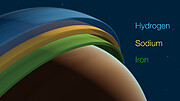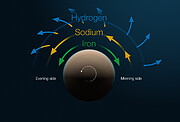Comunicato Stampa
"Oltre la fantascienza": le prime osservazioni 3D dell’atmosfera di un esopianeta rivelano un clima unico
18 Febbraio 2025
Gli astronomi hanno scrutato l'atmosfera di un pianeta oltre il Sistema Solare, mappandone per la prima volta la struttura tridimensionale. Combinando tutti e quattro i telescopi del VLT (Very Large Telescope) dell'ESO (Osservatorio Europeo Australe), hanno trovato venti potenti che trasportano elementi chimici come ferro e titanio, creando intricati andamento climatico nell'atmosfera del pianeta. La scoperta apre le porte a studi dettagliati della composizione chimica e meteorologica di altri mondi alieni.
"L'atmosfera del pianeta ha dei comportamenti che sfidano la nostra comprensione di come funziona il meteo, non solo sulla Terra, ma su tutti i pianeti. Sembra un film di fantascienza", afferma Julia Victoria Seidel, ricercatrice presso l'ESO (Osservatorio Europeo Australe) in Cile e autrice principale dello studio, pubblicato oggi su Nature.
Il pianeta, WASP-121b (noto anche come Tylos), si trova a circa 900 anni luce di distanza da noi nella costellazione della Poppa. È un pianeta gioviano ultra-caldo, un gigante gassoso che orbita così vicino alla stella madre che un anno lì dura solo circa 30 ore terrestri. Inoltre, un lato del pianeta è rovente, poiché è sempre rivolto verso la stella, mentre l'altro lato è molto più freddo.
Il gruppo di lavoro ha esplorato in profondità l'atmosfera di Tylos e ha rivelato venti distinti in strati separati, che risultano nella mappa tridimensionale della struttura dell'atmosfera. È la prima volta che gli astronomi hanno potuto studiare l'atmosfera di un pianeta al di fuori del Sistema Solare in modo così approfondito e dettagliato.
"Ciò che abbiamo scoperto è stato sorprendente: una corrente a getto fa ruotare il materiale intorno all'equatore del pianeta, mentre un flusso separato ai livelli inferiori dell'atmosfera sposta il gas dal lato caldo a quello più freddo. Questo tipo di clima non è mai stato osservato prima su nessun pianeta", afferma Seidel, che è anche ricercatrice presso il Lagrange Laboratory, parte dell'Observatoire de la Côte d'Azur, in Francia. La corrente a getto osservata attraversa metà del pianeta, guadagnando velocità e scuotendo violentemente gli strati superiori dell'atmosfera mentre attraversa il lato caldo di Tylos. "Persino i più violenti uragani del Sistema Solare sembrano un venticello al confronto", aggiunge.
Per scoprire la struttura 3D dell'atmosfera dell'esopianeta, il gruppo ha utilizzato lo strumento ESPRESSO installato sul VLT dell'ESO per combinare la luce dei quattro telescopi individuali in un singolo segnale. Questa modalità di combinazione del VLT raccoglie quattro volte più luce di un singolo telescopio, permettendo di rivelare dettagli più deboli. Osservando il pianeta per un transito completo davanti alla stella madre, ESPRESSO ha trovato l'impronta di vari elementi chimici, sondando di conseguenza diversi strati dell'atmosfera.
"Il VLT ci ha permesso di sondare tre diversi strati dell'atmosfera dell'esopianeta in un colpo solo", afferma il coautore dello studio Leonardo A. dos Santos, astronomo assistente presso lo Space Telescope Science Institute di Baltimora, USA. Il gruppo ha tracciato i moti di ferro, sodio e idrogeno, che hanno permesso di tracciare i venti rispettivamente nello strato profondo, intermedio e superficiale dell'atmosfera del pianeta. "È il tipo di osservazione che è molto difficile da fare con i telescopi spaziali, evidenziando l'importanza delle osservazioni da terra degli esopianeti", conclude.
È interessante notare che le osservazioni hanno anche rivelato la presenza di titanio appena sotto la corrente a getto, come evidenziato in uno studio correlato pubblicato su Astronomy and Astrophysics. Questa è stata un'altra sorpresa, poiché le precedenti osservazioni del pianeta avevano mostrato che questo elemento era assente, forse proprio perché nascosto in profondità nell'atmosfera.
"È davvero incredibile che siamo in grado di studiare dettagli come la composizione chimica e la struttura climatica di un pianeta a una distanza così grande", commenta Bibiana Prinoth, una studentessa di dottorato presso l'Università di Lund, Svezia, e l'ESO, che ha guidato lo studio complementare ed è co-autrice dell'articolo di Nature.
Per studiare l'atmosfera di pianeti più piccoli, simili alla Terra, tuttavia, saranno necessari telescopi più grandi. Tra questi ci saranno l'ELT (Extremely Large Telescope) dell'ESO, attualmente in costruzione nel deserto di Atacama in Cile, e il suo strumento ANDES. "L'ELT sarà uno strumento di svolta per lo studio delle atmosfere degli esopianeti", afferma Prinoth. "Questa esperienza mi fa sentire come se fossimo sul punto di scoprire cose incredibili che ora possiamo solo sognare".
Ulteriori Informazioni
Questo studio è stato presentato in un articolo pubblicato dalla rivista Nature intitolato “Vertical structure of an exoplanet’s atmospheric jet stream” (doi:10.1038/s41586-025-08664-1).
L'equipe è composta da : Julia V. Seidel (European Southern Observatory, Santiago, Cile [ESO Chile]; Laboratoire Lagrange, Observatoire de la Côte d’Azur, CNRS, Université Côte d’Azur, Nice, Francia [Lagrange]), Bibiana Prinoth (ESO Chile e Lund Observatory, Division of Astrophysics, Department of Physics, Lund University, Lund, Svezia [ULund]), Lorenzo Pino (INAF-Osservatorio Astrofisico di Arcetri, Firenze, Italia), Leonardo A. dos Santos (Space Telescope Science Institute, Baltimore, USA, Johns Hopkins University, Baltimore, USA), Hritam Chakraborty (Observatoire de Genève, Département d’Astronomie, Université de Genève, Versoix, Svizzera [UNIGE]), Vivien Parmentier (Lagrange), Elyar Sedaghati (ESO Chile), Joost P. Wardenier (Département de Physique, Trottier Institute for Research on Exoplanets [IREx], Université de Montréal, Canada), Casper Farret Jentink (UNIGE), Maria Rosa Zapatero Osorio (Centro de Astrobiología, CSIC-INTA, Madrid, Spagna), Romain Allart (IREx), David Ehrenreich (UNIGE), Monika Lendl (UNIGE), Giulia Roccetti (European Southern Observatory, Garching bei München, Germania; Meteorologisches Institut, Ludwig-Maximilians-Universität München, Munich, Germania), Yuri Damasceno (Instituto de Astrofísica e Ciências do Espaço, Universidade do Porto, Porto, Portogallo [IA-CAUP], Departamento de Fisica e Astronomia, Faculdade de Ciências, Universidade do Porto, Porto, Portogallo [FCUP]; ESO Chile), Vincent Bourrier (UNIGE), Jorge Lillo-Box (Centro de Astrobiología (CAB); CSIC-INTA, Madrid, Spagna), H. Jens Hoeijmakers (ULund), Enric Pallé (Instituto de Astrofísica de Canarias, La Laguna, Tenerife, Spagna [IAC]; Departamento de Astrofísica, Universidad de La Laguna, La Laguna, Tenerife, Spagna [IAC-ULL]), Nuno Santos (IA-CAUP e FCUP), Alejandro Suàrez Mascareño (IAC e IAC-ULL), Sergio G. Sousa (IA-CAUP), Hugo M. Tabernero (Departamento de Física de la Tierra y Astrofísica & IPARCOS-UCM (Instituto de Física de Partículas y del Cosmos de la UCM), Universidad Complutense de Madrid, Spagna), e Francesco A. Pepe (UNIGE).
L'articolo complementare, che rivela la presenza del titanio, è stato pubblicato dalla rivista Astronomy & Astrophysics con il titolo “Titanium chemistry of WASP-121 b with ESPRESSO in 4-UT mode” (doi: 10.1051/0004-6361/202452405)
L'equipe che ha collaborato a questo articolo è composta da : Bibiana Prinoth (European Southern Observatory, Santiago, Chile [ESO Chile] e Lund Observatory, Division of Astrophysics, Department of Physics, Lund University, Lund, Svezia [ULund]), Julia V. Seidel (ESO Chile; Laboratoire Lagrange, Observatoire de la Côte d’Azur, CNRS, Université Côte d’Azur, Nice, Francia [Lagrange]), H. Jens Hoeijmakers (ULund), Brett M. Morris (Space Telescope Science Institute, Baltimore, USA), Martina Baratella (ESO Chile), Nicholas W. Borsato (ULund, School of Mathematical and physical Sciences, Macquarie University, Sydney, Australia), Yuri Damasceno (Instituto de Astrofísica e Ciências do Espaço, Universidade do Porto, Porto, Portogallo [IA-CAUP], Departamento de Fisica e Astronomia, Faculdade de Ciências, Universidade do Porto, Porto, Portogallo [FCUP]; ESO Chile), Vivien Parmentier (Lagrange), Daniel Kitzmann (University of Bern, Physics Institute, Division of Space Research & Planetary Sciences, Bern, Svizzera), Elyar Sedaghati (ESO Chile), Lorenzo Pino (INAF-Osservatorio Astrofisico di Arcetri, Firenze, Italia), Francesco Borsa (INAF-Osservatorio Astronomico di Brera, Merate, Italia), Romain Allart (Département de Physique, Trottier Institute for Research on Exoplanets [IREx], Université de Montréal, Canada), Nuno Santos (IA-CAUP e FCUP), Michal Steiner (Observatoire de l'Université de Genève, Versoix, Svizzera), Alejandro Suàrez Mascareño (Instituto de Astrofísica de Canarias, La Laguna, Tenerife, Spagna; Departamento de Astrofísica, Universidad de La Laguna, La Laguna, Tenerife, Spagna), Hugo M. Tabernero (Departamento de Física de la Tierra y Astrofísica & IPARCOS-UCM (Instituto de Física de Partículas y del Cosmos de la UCM), Universidad Complutense de Madrid, Spagna) e Maria Rosa Zapatero Osorio (Centro de Astrobiologia, CSIC-INTA, Madrid, Spagna).
L'ESO (European Southern Observatory o Osservatorio Europeo Australe) consente agli scienziati di tutto il mondo di scoprire i segreti dell'Universo a beneficio di tutti. Progettiamo, costruiamo e gestiamo da terra osservatori di livello mondiale - che gli astronomi utilizzano per affrontare temi interessanti e diffondere il fascino dell'astronomia - e promuoviamo la collaborazione internazionale per l'astronomia. Fondato come organizzazione intergovernativa nel 1962, oggi l'ESO è sostenuto da 16 Stati membri (Austria, Belgio, Danimarca, Francia, Finlandia, Germania, Irlanda, Italia, Paesi Bassi, Polonia, Portogallo, Regno Unito, Repubblica Ceca, Spagna, Svezia e Svizzera), insieme con il paese che ospita l'ESO, il Cile, e l'Australia come partner strategico. Il quartier generale dell'ESO e il Planetario e Centro Visite Supernova dell'ESO si trovano vicino a Monaco, in Germania, mentre il deserto cileno di Atacama, un luogo meraviglioso con condizioni uniche per osservare il cielo, ospita i nostri telescopi. L'ESO gestisce tre siti osservativi: La Silla, Paranal e Chajnantor. Sul Paranal, l’ESO gestisce il VLT (Very Large Telescope) e il VLTI (Very Large Telescope Interferometer), così come telescopi per survey come VISTA. Sempre a Paranal l'ESO ospiterà e gestirà la schiera meridionale di telescopi di CTA, il Cherenkov Telescope Array Sud, il più grande e sensibile osservatorio di raggi gamma del mondo. Insieme con partner internazionali, l’ESO gestisce APEX e ALMA a Chajnantor, due strutture che osservano il cielo nella banda millimetrica e submillimetrica. A Cerro Armazones, vicino a Paranal, stiamo costruendo "il più grande occhio del mondo rivolto al cielo" - l'ELT (Extremely Large Telescope, che significa Telescopio Estremamente Grande) dell'ESO. Dai nostri uffici di Santiago, in Cile, sosteniamo le operazioni nel paese e collaboriamo con i nostri partner e la società cileni.
La traduzione dall'inglese dei comunicati stampa dell'ESO è un servizio dalla Rete di Divulgazione Scientifica dell'ESO (ESON: ESO Science Outreach Network) composta da ricercatori e divulgatori scientifici da tutti gli Stati Membri dell'ESO e altri paesi. Il nodo italiano della rete ESON è gestito da Anna Wolter.
Links
- Articolo scientifico (Nature)
- Articolo scientifico (A&A)
- Fotografie del VLT
- Scoprite ulteriori informazioni sull'ELT (Extremely Large Telescope) dell'ESO's sul sito dedicato e nella cartella stampa
- Per i giornalisti: iscrivetevi per ricevere i nostri comunicati sotto embargo nella vostra lingua e fate domanda per un visita strategica all'ESO (con parziale supporto finanziario) nel 2025 (Novità)
- Per i ricercatori: avete una storia da raccontare? Promuovete il vostro articolo scientifico
- A rischio i cieli più bui e più limpidi del mondo a causa di un megaprogetto industriale
Contatti
Julia Victoria Seidel
European Southern Observatory (ESO) and Lagrange Laboratory, Observatoire de la Côte d'Azur
Santiago, Chile and Nice, France
Tel.: +33 743 32 79 73
E-mail: jseidel@oca.eu
Bibiana Prinoth
Lund University
Lund, Sweden
Tel.: +46 72 442 03 69
E-mail: bibiana.prinoth@fysik.lu.se
Leonardo A. dos Santos
Space Telescope Science Institute
Baltimore, USA
Tel.: +1 (410) 338-4395
E-mail: ldsantos@stsci.edu
Bárbara Ferreira
ESO Media Manager
Garching bei München, Germany
Tel.: +49 89 3200 6670
Cell.: +49 151 241 664 00
E-mail: press@eso.org
Anna Wolter (press contact Italia)
Rete di divulgazione scientifica dell'ESO
e INAF-Osservatorio Astronomico di Brera
Milano, Italy
Tel.: +39 02 72320321
E-mail: eson-italy@eso.org
Sul Comunicato Stampa
| Comunicato Stampa N": | eso2504it |
| Nome: | WASP-121b |
| Tipo: | Milky Way : Star : Circumstellar Material : Planetary System |
| Facility: | Very Large Telescope |
| Instruments: | ESPRESSO |
| Science data: | 2025Natur.639..902S |
Our use of Cookies
We use cookies that are essential for accessing our websites and using our services. We also use cookies to analyse, measure and improve our websites’ performance, to enable content sharing via social media and to display media content hosted on third-party platforms.
ESO Cookies Policy
The European Organisation for Astronomical Research in the Southern Hemisphere (ESO) is the pre-eminent intergovernmental science and technology organisation in astronomy. It carries out an ambitious programme focused on the design, construction and operation of powerful ground-based observing facilities for astronomy.
This Cookies Policy is intended to provide clarity by outlining the cookies used on the ESO public websites, their functions, the options you have for controlling them, and the ways you can contact us for additional details.
What are cookies?
Cookies are small pieces of data stored on your device by websites you visit. They serve various purposes, such as remembering login credentials and preferences and enhance your browsing experience.
Categories of cookies we use
Essential cookies (always active): These cookies are strictly necessary for the proper functioning of our website. Without these cookies, the website cannot operate correctly, and certain services, such as logging in or accessing secure areas, may not be available; because they are essential for the website’s operation, they cannot be disabled.
Functional Cookies: These cookies enhance your browsing experience by enabling additional features and personalization, such as remembering your preferences and settings. While not strictly necessary for the website to function, they improve usability and convenience; these cookies are only placed if you provide your consent.
Analytics cookies: These cookies collect information about how visitors interact with our website, such as which pages are visited most often and how users navigate the site. This data helps us improve website performance, optimize content, and enhance the user experience; these cookies are only placed if you provide your consent. We use the following analytics cookies.
Matomo Cookies:
This website uses Matomo (formerly Piwik), an open source software which enables the statistical analysis of website visits. Matomo uses cookies (text files) which are saved on your computer and which allow us to analyze how you use our website. The website user information generated by the cookies will only be saved on the servers of our IT Department. We use this information to analyze www.eso.org visits and to prepare reports on website activities. These data will not be disclosed to third parties.
On behalf of ESO, Matomo will use this information for the purpose of evaluating your use of the website, compiling reports on website activity and providing other services relating to website activity and internet usage.
Matomo cookies settings:
Additional Third-party cookies on ESO websites: some of our pages display content from external providers, e.g. YouTube.
Such third-party services are outside of ESO control and may, at any time, change their terms of service, use of cookies, etc.
YouTube: Some videos on the ESO website are embedded from ESO’s official YouTube channel. We have enabled YouTube’s privacy-enhanced mode, meaning that no cookies are set unless the user actively clicks on the video to play it. Additionally, in this mode, YouTube does not store any personally identifiable cookie data for embedded video playbacks. For more details, please refer to YouTube’s embedding videos information page.
Cookies can also be classified based on the following elements.
Regarding the domain, there are:
- First-party cookies, set by the website you are currently visiting. They are stored by the same domain that you are browsing and are used to enhance your experience on that site;
- Third-party cookies, set by a domain other than the one you are currently visiting.
As for their duration, cookies can be:
- Browser-session cookies, which are deleted when the user closes the browser;
- Stored cookies, which stay on the user's device for a predetermined period of time.
How to manage cookies
Cookie settings: You can modify your cookie choices for the ESO webpages at any time by clicking on the link Cookie settings at the bottom of any page.
In your browser: If you wish to delete cookies or instruct your browser to delete or block cookies by default, please visit the help pages of your browser:
Please be aware that if you delete or decline cookies, certain functionalities of our website may be not be available and your browsing experience may be affected.
You can set most browsers to prevent any cookies being placed on your device, but you may then have to manually adjust some preferences every time you visit a site/page. And some services and functionalities may not work properly at all (e.g. profile logging-in, shop check out).
Updates to the ESO Cookies Policy
The ESO Cookies Policy may be subject to future updates, which will be made available on this page.
Additional information
For any queries related to cookies, please contact: pdprATesoDOTorg.
As ESO public webpages are managed by our Department of Communication, your questions will be dealt with the support of the said Department.





